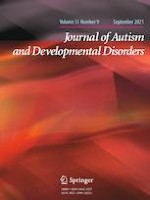20-11-2020 | Original Paper
A Pilot Study of Responses to Interparental Conflict in Children with Autism Spectrum Disorder
Gepubliceerd in: Journal of Autism and Developmental Disorders | Uitgave 9/2021
Log in om toegang te krijgenAbstract
Research supports that parents of children with ASD experience higher rates of marital conflict compared to parents of neurotypically developing (NT) children; however, no known research examining reactions to interparental conflict in children with ASD exists. This study compared emotional, behavioral, and physiological responses to interparental conflict in ASD (n = 21) and NT children (n = 29). Children were presented with videotaped interactions (constructive vs. destructive conflict) of actors and their reactions were measured. Children with ASD reported higher levels of negative emotions following constructive conflict compared to NT children. Parents of children with ASD rated their child’s emotional and behavioral responses to interparental conflict more negatively than parents of NT children. Comparable levels of physiological reactivity were found across both groups.
